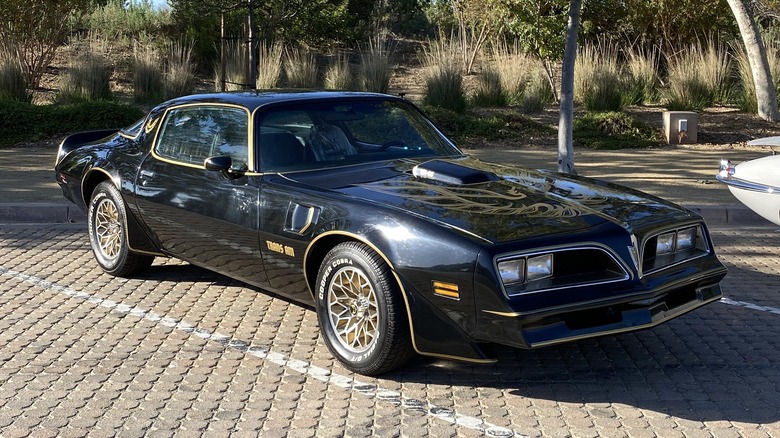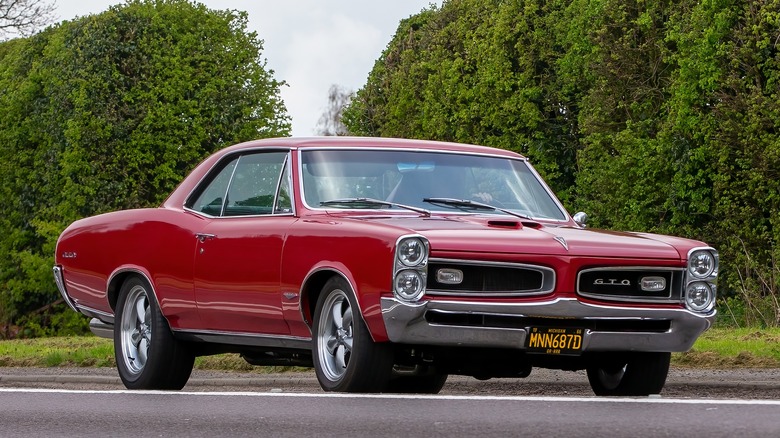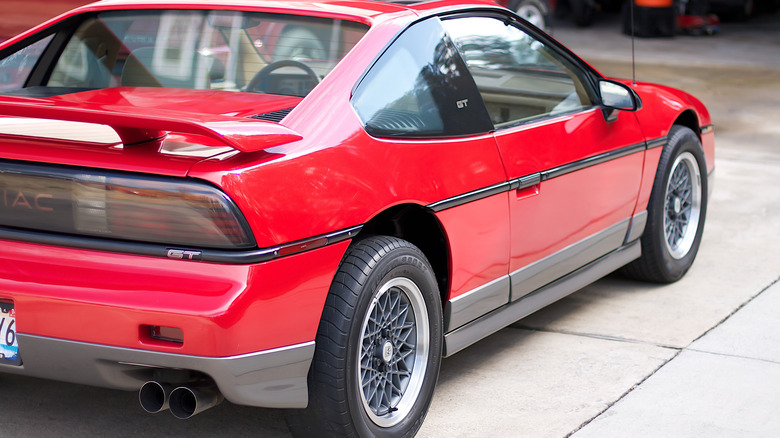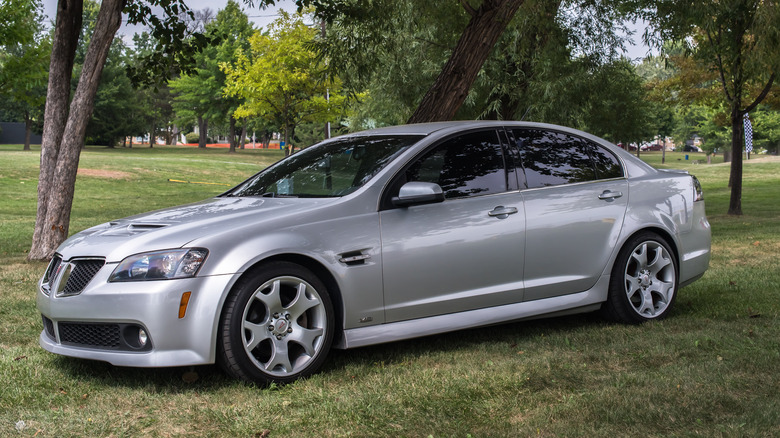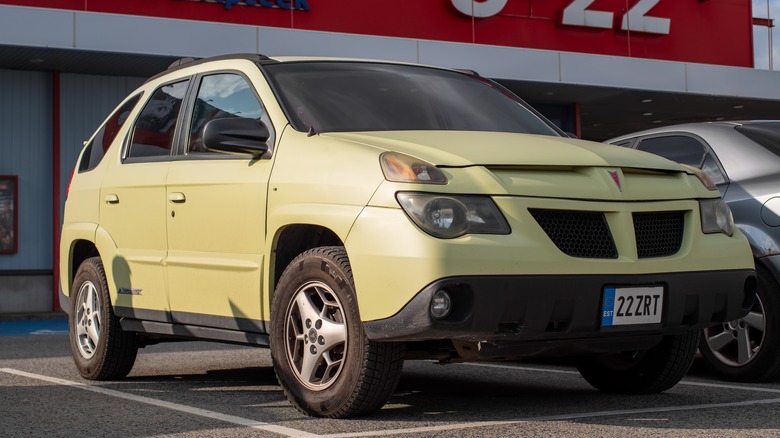5 Classic Pontiac Cars We Want To See Come Back
Pontiac has a long history as an automotive brand. Most casual observers know it was a General Motors brand, but it's less common knowledge that the Pontiac roots go back as far as the late 1800s. Bought by GM in the early 1900s, Pontiac made cars for nearly 100 years. Many of those cars shared architecture or parts with Chevrolet products, but they had a style and presence all their own. Pontiac's history is full of iconic sports cars, big coupes, historic muscle cars, mid-engine sports cars, and even strange SUVs.
Unfortunately, the brand is dead and has been so for over a decade. With such a long history, there are several vehicles in Pontiac's history that deserve a new life. The GMC Hummer EV is an example of the kind of revival that Pontiac could experience. GM knew the Hummer brand had some sway, so they brought the name and styling back with a modern electric execution. There's a similar opportunity with many of the deceased Pontiac automobiles. GM could capitalize on the familiarity and brand enthusiasm behind some Pontiac vehicles, giving them new life and attracting a big group of nostalgic buyers. Perhaps they could do it with these five vehicles.
Firebird
With a fiery phoenix on the hood and decades of history behind it, the Pontiac Firebird is an obvious first choice for a Pontiac that deserves a resurrection. One of Pontiac's most iconic cars, the Firebird was a two-door coupe based on the Chevrolet Camaro. The Firebird and Camaro weren't quite the same car, but they were close relatives their entire lives. Both debuted in the late 1960s, sharing the General Motors F-body platform. They shared engines and platforms over the years, remaining closely related until they were both discontinued in 2002. But it's not the first time Chevrolet stopped producing the Camaro, and it probably won't be the last.
Chevy killed the Camaro in 2002, then brought it back in 2010, giving it new life for over a decade until they said goodbye to it again last year. Of course, they admitted that it was "not the end of the Camaro's story," so it's not hard to imagine that the Firebird could come back too. The natural form for a Firebird would be to coexist with the Camaro and share powertrains, with the potential for GM to add unique suspension components or styling to give it a distinct personality. Performance variants would be a natural inclusion for any Firebird/Camaro lineup, and a potential top-of-the-line Trans Am model could be in the cards, too. Of course, we'd want some sort of screaming chicken on the hood.
GTO
It's hard to get a consensus on what the first muscle car was. Historians may point to cars that were high-horsepower for their time, like the 1949 Oldsmobile Rocket 88, but Pontiac enthusiasts will point to the legendary 1964 GTO as the first true muscle car.
Based on the Pontiac Tempest, a relatively tame and average car, the '64 GTO was originally an option that added a big 389-cubic-inch V8. It was lightweight and had big power compared to the standard 330-cubic-inch engine in the standard Tempest. The base GTO had 325 horsepower, while optional packages offered upgraded carburetors and a power rating of 358 horses — making it seriously fast, even by modern standards.
In a 1964 Car and Driver test, a '64 GTO went from zero to 60 mph in just 4.6 seconds — fast enough to beat many modern family sedans and SUVs, while nearly keeping up with modern muscle cars like the Dodge Challenger (zero to 60 mph in 4.2 seconds). On top of being fast, it's also one of the coolest-looking Pontiac models ever made, so a revived GTO could be the source of some nostalgic styling details, too.
Fiero
The Pontiac Fiero was short-lived, but it left an indelible mark on car culture. Originally released in 1984, the Fiero was discontinued by 1988, despite some strong early sales and an inclusion on the 1984 Car and Driver 10 Best list. It was small, agile, and mid-engine – unique for an American car.
What made the Fiero so short-lived? Well, there was a pesky issue where some Fieros caught fire. Then, there were some oil-starvation issues that plagued Fieros with the 2.5-liter four-cylinder engine. Although no deaths resulted from the aforementioned fires, some significant PR damage was done. To top it all off, despite looking sporty, early four-cylinder models were underpowered and relatively slow. All of this led to a sales slump for the Fiero, which would eventually be killed off after just five years on the market.
So why would we want the Fiero to make a comeback? Because it was fun. The Fiero was excellent to drive (especially the V6-powered GT models), and mid-engine sports cars are rare, especially at an affordable price point. Power could be provided by a turbocharged four-cylinder engine, an electric powertrain, or potentially the option for both. The only real requirement for a new Fiero would be the fun factor. Just make it an entertaining two-seater with a bit of 80s attitude and a lot less combustion, and you're good to go.
G8
While it isn't as well-known or historically significant as the Firebird or the GTO, the Pontiac G8 is still worthy of the modern-classic moniker. Built by Holden in Australia and then shipped to the United States, the G8 was even shorter-lived than the Fiero. It was introduced in 2008, but when Pontiac shut its doors in 2009, the G8 became unavailable, too.
At its launch in 2008, the G8 was available with a 3.6-liter V6 and a 6.0-liter V8, putting out 256 horsepower and 361 horsepower, respectively. That made it a perfect competitor for muscle-sedans like the Dodge Charger. The performance of both engines was adequate, but the real star of the show was the 6.2-liter V8, which was introduced in 2009. The 6.2-liter V8 produced 415 horsepower, and it was paired with a six-speed manual transmission, sending power to the rear wheels – excellent news for driving enthusiasts. The same 6.2-liter V8 and six-speed manual would eventually be used in the Chevrolet SS, an excellent sleeper car with its plain exterior and fire-breathing powertrain.
A modern G8 would likely follow the same formula – a powerful V8 with rear-wheel drive and a manual transmission. While that combination isn't exactly a formula for sales success amongst the current crop of fuel-efficient hybrids and family-transport SUVs, it's still fun to dream that one could exist.
Aztek
There have been faster, better-looking, better-loved, more well-reviewed, and better-selling models than the Aztek throughout Pontiac's history. It would be easy to make a case for any number of Pontiacs to take the Aztek's place on this list — cars like the LeMans, Grand Prix, Streamliner and Deluxe all come to mind. One could even make a case for more modern vehicles like the Vibe or the Solstice to be revived. But the Aztek has a strange design and the opportunity to be a weirdly successful brand ambassador.
With plastic cladding, strangely-stacked headlights, a four-part front grille, and funky three-spoke wheels, the Aztek isn't winning any design competitions. When it comes to features, however, it was actually ahead of its time. It had available gear like an inflatable mattress for the rear, a factory-built tent that was mounted on the back of the vehicle, and a removable cooler between the front seats.
Forward-facing features, strange options, and quirky styling cues – that's where the Aztek could live. If it were ever revived, it could be a test vehicle for any unhinged and strange new features that engineers want to try out. It could be offered in strange colors or with weird livery choices. The fact that the Aztek was such a failure means that it has low expectations now — making it a perfect candidate for the most bizarre ideas GM engineers can come up with.

